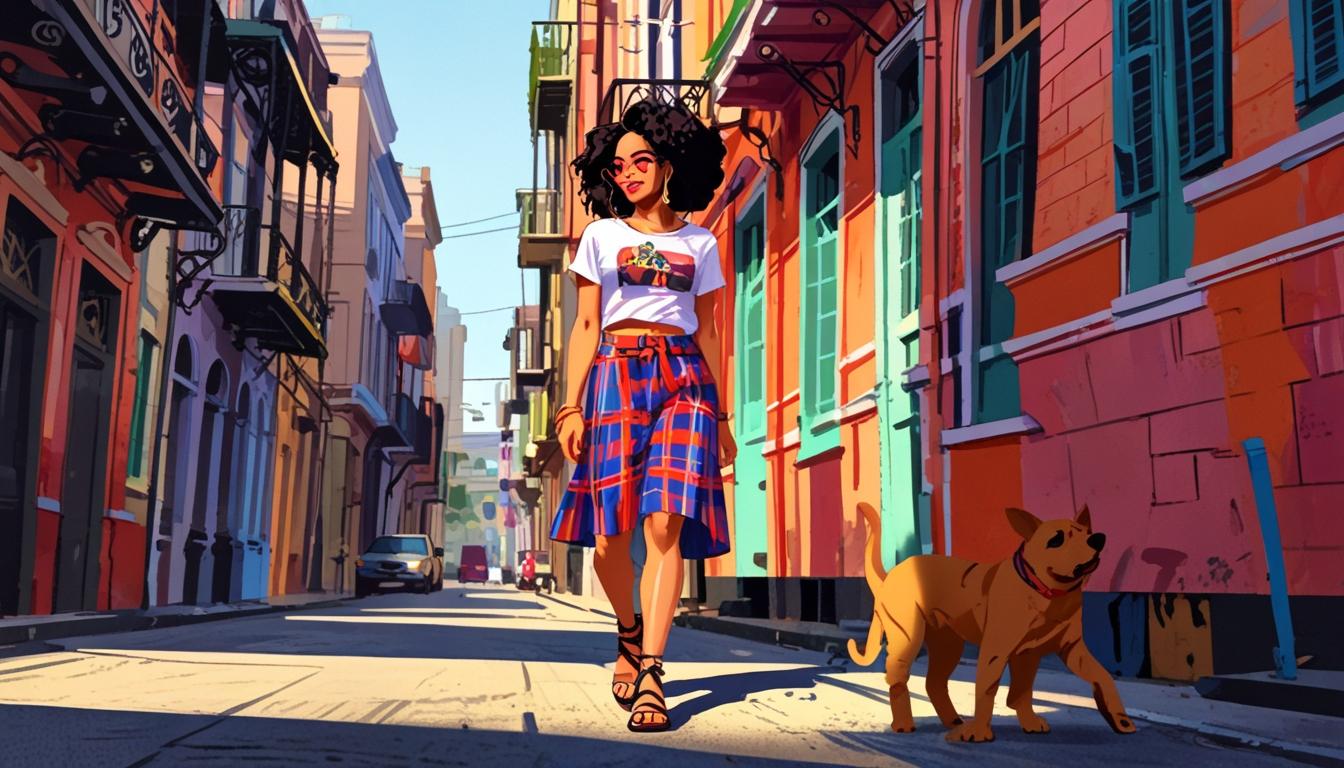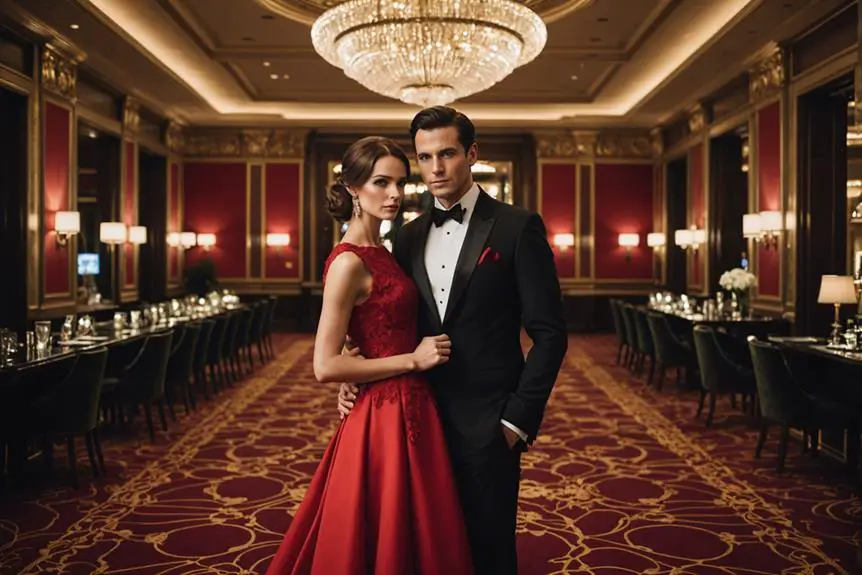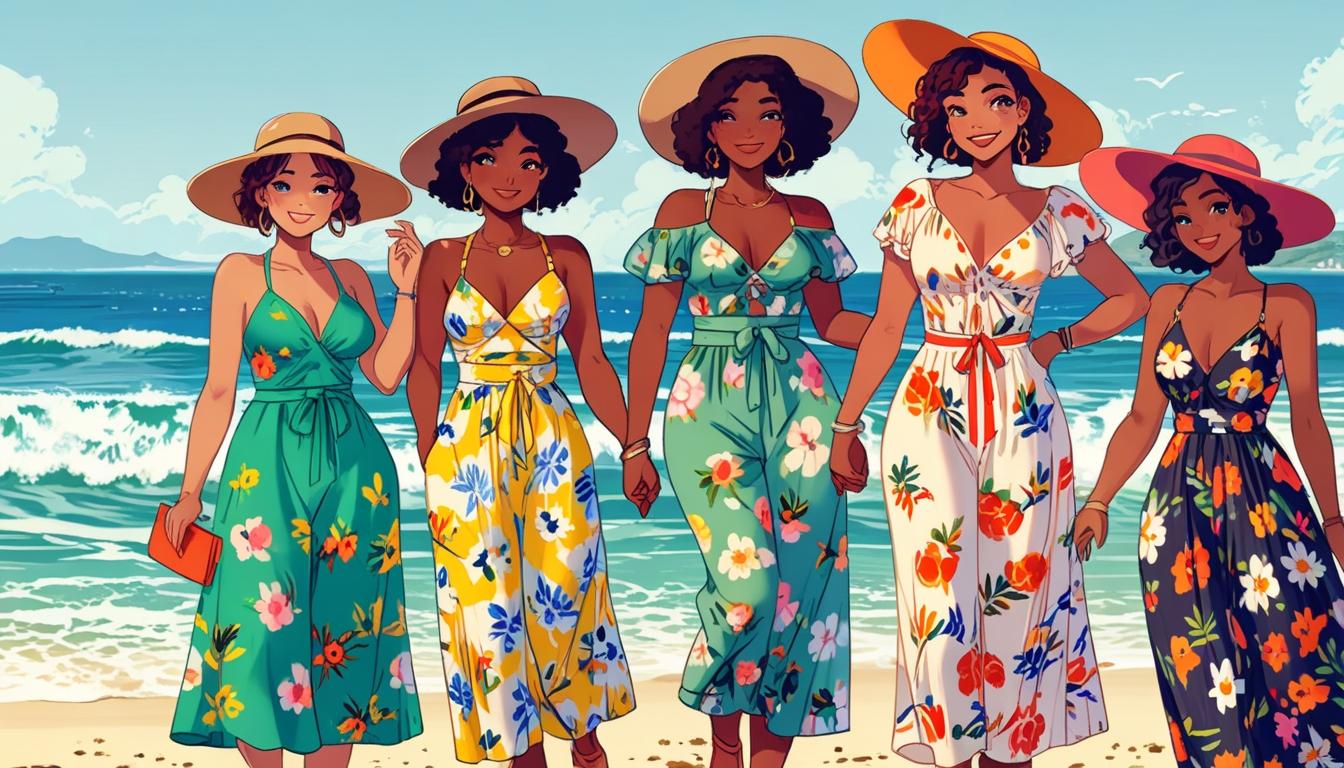Consider how Diane Keaton's choice to wear a bowler hat in *Annie Hall* transformed perceptions of women's fashion in the 1970s. This single accessory symbolizes a broader cultural shift where androgynous styles gained prominence. As you explore the film's iconic outfits, you'll notice the significant impact they had on contemporary fashion trends. What does this say about the interplay between film and personal style, and how might it inform current fashion choices?
Overview of Annie Hall
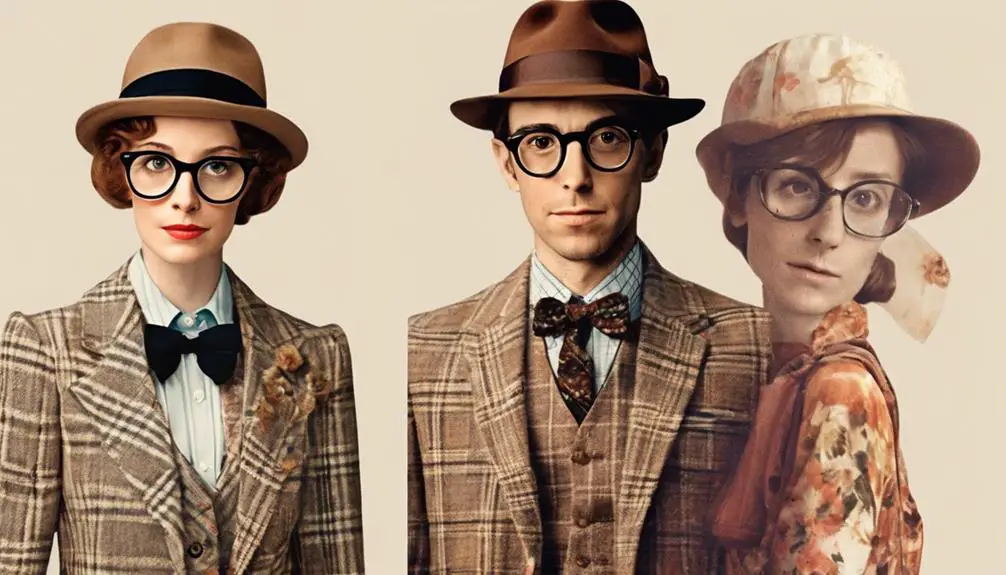
"Annie Hall," directed by Woody Allen and released in 1977, stands out as a landmark film that not only captivated audiences but also transformed the landscape of fashion.
Diane Keaton, portraying the titular character, showcased an iconic ensemble that blurred the lines between menswear and women's fashion. The film's wardrobe drew heavily from Keaton's personal collection, featuring layered, oversized pieces that spoke to the bohemian and androgynous styles of the late 1970s.
The fashion choices in "Annie Hall" can be seen as a reflection of the era's cultural shifts, similar to how vintage Adidas logos signify different periods in sportswear history.
Costume designer Ruth Morley faced initial skepticism regarding Keaton's unique clothing choices but ultimately collaborated with Ralph Lauren to create a distinctive aesthetic. This included khaki pants, vests, and neckties, elements that became synonymous with Annie Hall's character.
The inspiration drawn from SoHo street style added an authentic urban flair that resonated with audiences.
The impact of "Annie Hall" on fashion remains profound, influencing contemporary designers and style icons alike.
Today, you can see echoes of this film's wardrobe in modern fashion trends, solidifying its status as a cultural reference point in fashion history.
The film not only tells a story but also leaves a lasting legacy in the world of fashion, inviting you to explore its vibrant influence.
Key Fashion Elements
The film's key fashion elements showcase a striking blend of androgyny and bohemian flair that defined 1970s women's style. In *Annie Hall*, Diane Keaton's character becomes a fashion icon, frequently sporting oversized separates that embody the era's laid-back yet chic aesthetic.
Layering is essential here; you'll notice how she mixes and matches dad pants with tailored blazers, creating a striking contrast that feels effortlessly stylish. Ralph Lauren's designs, known for their classic menswear influences, align perfectly with this aesthetic, making them a natural choice for the film's costume design.
Additionally, vintage Ralph Lauren pieces, particularly those from the 1970s, often feature unique tag designs that add to their charm and authenticity, showcasing the brand's evolution over time key identifier.
Keaton's embrace of menswear details, like neckties and vests, reflects a cultural shift towards more androgynous styles in women's clothing. Her iconic bowler hat, inspired by French actress Aurore Clément, adds an extra layer of flair, making it a staple piece in her wardrobe.
Ralph Lauren's contribution to the film's costume design plays a significant role, merging classic menswear with contemporary elements, ultimately shaping the film's unique fashion narrative.
This combination of relaxed silhouettes, tailored pieces, and bold accessories not only highlights the character's individuality but also cements *Annie Hall* as a pivotal moment in fashion history.
Diane Keaton's Style Influence
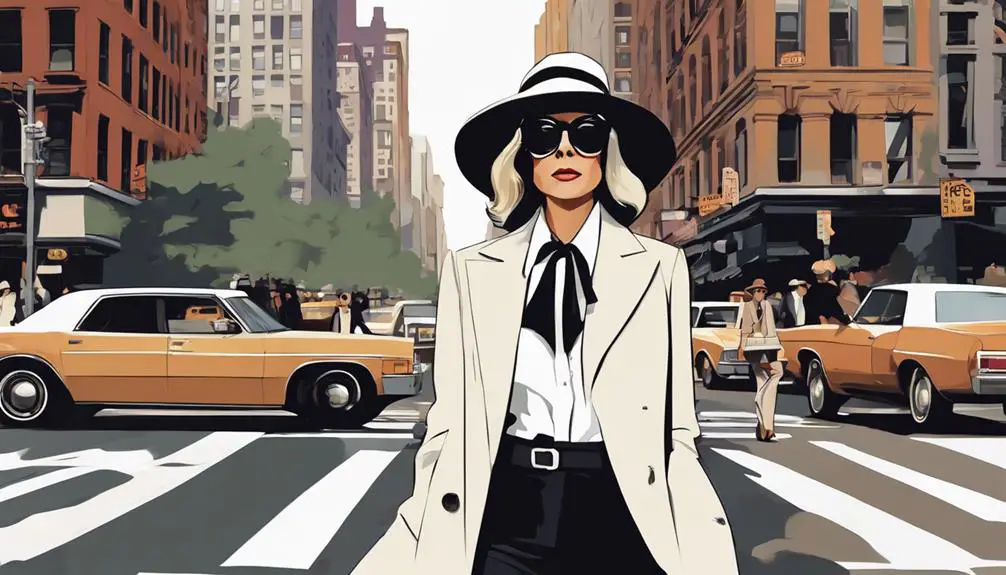
Diane Keaton's unique style in *Annie Hall* not only captivated audiences but also sparked a menswear-inspired revolution in women's fashion. By embracing items like khaki pants, vests, and neckties, Diane Keaton redefined femininity through an androgynous lens.
Her personal wardrobe heavily influenced Annie's looks, merging elements of 1920s and 1940s menswear with the bohemian flair of the 1960s and 1970s. This blend created a truly unique aesthetic that resonated with many, showcasing the impact of popular decades and styles on contemporary fashion.
The iconic bowler hat, inspired by a production designer's partner, added a distinctive touch that defined Annie's character. Keaton's desire for a casual, androgynous style encouraged women to adopt oversized separates and layering techniques, leading to a significant cultural shift in fashion.
Working closely with costume designer Ruth Morley, Keaton's input was essential in shaping the film's stylistic choices.
As a fashion icon, Diane Keaton's influence continues to inspire modern designers and celebrities alike. The looks she popularized in *Annie Hall* remain relevant today, proving that pushing the boundaries of style can create a lasting impact on the fashion landscape.
Cultural Impact on Fashion
Revolutionizing fashion norms, *Annie Hall* introduced an androgynous aesthetic that shifted how women approached their wardrobes. Diane Keaton's character became an instant fashion icon, showcasing the power of menswear-inspired styles that encouraged women to wear what was traditionally seen as masculine.
This evolution in women's fashion parallels the 1960s rise of wrap coats, which also represented a shift towards versatile and functional outerwear, as seen in the evolution of wrap coats. Annie's khaki pants, vests, and playful bowler hats not only became key wardrobe staples but also symbolized a liberating shift in women's fashion during the late 1970s.
The cultural impact of *Annie Hall* resonates even today, as contemporary designers often revisit and draw inspiration from this tomboyish aesthetic. Ralph Lauren's recent collections highlight this influence, featuring pieces reminiscent of Keaton's style that celebrate the charm of borrowed-from-the-boys looks.
As fashion publications frequently celebrate the Annie Hall aesthetic, it's clear that this film continues to inspire new generations of designers and style icons.
Iconic Outfits From the Film
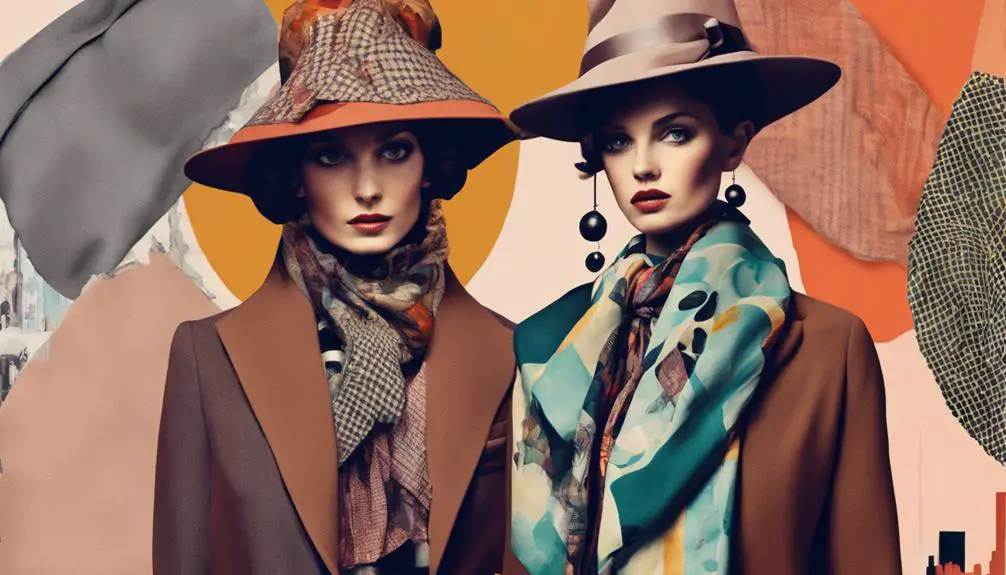
*Annie Hall* features several iconic outfits that have become timeless symbols of 70s fashion. Diane Keaton, portraying the quirky yet charming Annie, effortlessly blends menswear with feminine flair, creating a unique style that resonates with fashion enthusiasts.
One standout look is her floral maxi dress worn over a turtleneck, which captures the essence of bohemian style and has made resurgences in fashion trends from the 90s to today.
Annie's "dad pants" and wide trousers showcase her affinity for relaxed silhouettes, further blurring the lines between menswear and women's fashion. One of her most memorable outfits includes a cropped khaki vest paired with a brown tweed blazer, exuding a chic yet laid-back vibe inspired by equestrian fashion.
Additionally, her first meeting outfit, featuring loose khakis, a black vest, and her signature bowler hat, perfectly encapsulates the film's menswear-inspired aesthetic.
Many of Keaton's outfits, with their oversized separates and clever use of accessories like scarves and hats, continue to inspire countless designers, proving that Annie Hall's iconic outfits remain relevant in contemporary style.
Social Media Engagement
Fashion lovers are embracing the iconic looks from *Annie Hall* on social media, sparking vibrant conversations and creativity. Recently, Ainslie from the Ian Drummond Collection styled an Instagram video breakdown of the film's memorable outfits, inviting fashion enthusiasts to immerse themselves in the fun.
This engaging content encourages viewers to share their interpretations of Annie Hall-inspired outfits in the comments, creating an interactive experience that strengthens the community. Followers aren't just passive observers; they're invited to post their own looks influenced by the film, making social media a lively marketplace for these iconic styles.
Through platforms like GlamAmor, fans of classic fashion can discover upcoming discussions and events, further enriching their connection to this beloved film. The engagement goes beyond visual content; followers can also subscribe via email for updates on fashion history topics and community discussions, ensuring they stay informed and involved.
This dynamic interaction fosters a sense of belonging among fans, as they celebrate and reinterpret the timeless fashion showcased in *Annie Hall*. So, if you haven't joined in yet, now's the perfect time to explore and share your own Annie Hall looks!
Events and Community Discussions

Amidst the vibrant discussions surrounding classic film fashion, upcoming events are set to deepen your appreciation for the iconic styles showcased in *Annie Hall*. On April 17, the "Fashion in Film of TCMFF 2024" will explore how Diane Keaton's character revolutionized womenswear by seamlessly blending menswear elements.
This event promises to highlight *Annie Hall* as a pivotal influence among fashion icons, inspiring enthusiasts to rethink their approach to classic film fashion.
GlamAmor provides an engaging platform for community involvement, offering resources like a YouTube channel and active social media discussions. You'll find opportunities to share your own interpretations of Diane Keaton's unforgettable looks, whether it's a quirky tie or a tailored vest.
Moreover, past fashion history events are available for on-demand viewing, allowing you to investigate the cultural impact of films like *Annie Hall* on stylish trends.
Collaborative efforts with film organizations enhance these discussions, bringing insights from film historians and enthusiasts alike. So, join the conversation and immerse yourself in the world of *Annie Hall*, where fashion and film intertwine in delightful ways, especially in the creative hub of SoHo!
Legacy of Annie's Wardrobe
The legacy of Annie Hall's wardrobe continues to shape the fashion landscape decades after its debut. Diane Keaton, embodying the quirky character of Annie Hall, introduced a style that boldly embraced menswear. With outfits featuring khaki pants, vests, and neckties, she initiated a significant shift toward casual styles and androgynous looks for women in the late 1970s.
Annie Hall became a fashion icon, with her signature bowler hat and eclectic layers influencing countless designers like Jenna Lyons and Rachel Zoe. The film's costume design, especially a collaboration with Ralph Lauren, established an aesthetic that has been revisited in numerous collections and editorials over the years.
Today, modern interpretations of Annie's style grace red carpets and fashion runways alike, reaffirming the film's enduring impact on fashion trends and the portrayal of women's identities in cinema.
You can still see the echoes of this legacy in how casual styles have evolved, making it clear that Annie Hall isn't just a film; it's a timeless influence that celebrates individuality and challenges traditional fashion norms.
Frequently Asked Questions
Why Does Diane Keaton Dress Like Annie Hall?
Diane Keaton's style embodies personal expression, challenging gender norms through iconic outfits. Her fashion influence and vintage aesthetics reflect a cultural impact, showcasing how her wardrobe choices resonate with individuality and defy traditional expectations.
Who Designed the Clothes for Annie Hall?
Imagine bold 1970s trends clashing with personal expression. The costume designer crafted iconic style through wardrobe choices that highlighted character development, influencing fashion long after. Those outfits became timeless symbols of individuality and cinematic creativity.
What Was the Annie Hall Look Like?
Annie Hall's style blends iconic fashion and vintage influences, showcasing 1970s trends. You'll notice quirky accessories and layered separates reflecting character expression, emphasizing wardrobe significance in redefining femininity and androgyny in fashion during that era.
Did Diane Keaton Sing in the Movie Annie Hall?
Though Diane Keaton's vocals aren't featured in "Annie Hall," the film's soundtrack enhances character development. With no singing scenes, her performance critique focuses on her quirky charm, showcasing musical influences rather than vocal talent.

